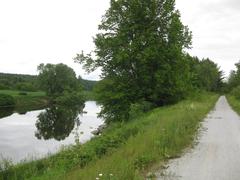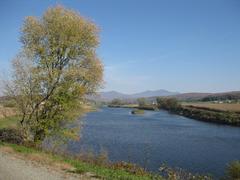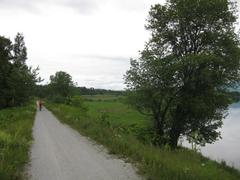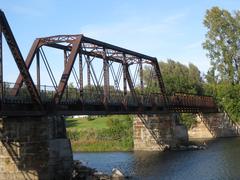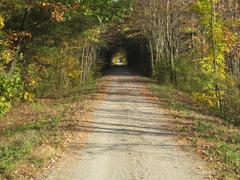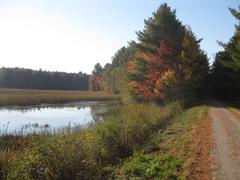
Comprehensive Guide to Visiting Missisquoi Valley Rail Trail in Saint Albans, United States
Publication Date: 01/08/2024
Introduction to Missisquoi Valley Rail Trail
Nestled in the heart of northwestern Vermont, the Missisquoi Valley Rail Trail (MVRT) offers a blend of scenic beauty, rich history, and diverse recreational activities. Spanning 26.4 miles from Saint Albans to Richford, this trail is a testament to the region’s vibrant past and its commitment to preserving natural and historical treasures. Originally a bustling rail line in the late 19th century, the MVRT has transformed into a multi-use trail that attracts history enthusiasts, nature lovers, and outdoor adventurers alike (TrailLink). This comprehensive guide will delve into the trail’s origins, significance, and provide essential visitor information, ensuring a memorable experience for all who explore this remarkable corridor.
Table of Contents
- Introduction
- History and Significance
- Historical Landmarks Along the Trail
- Economic and Social Impact
- Environmental and Recreational Significance
- Community Engagement and Preservation
- Visitor Information
- Special Events and Tours
- Future Prospects and Challenges
- FAQ
- Conclusion
Exploring the Missisquoi Valley Rail Trail: History, Significance, and Visitor Information
History and Significance
Origins and Development
The MVRT traces its origins back to the late 19th century. Initially chartered as the Missisquoi Railroad in the late 1860s, the line between Saint Albans and Richford was leased by the Central Vermont Railroad in 1872. This rail line played a crucial role in the economic development of northwestern Vermont, facilitating the transport of goods and passengers through the region. Eventually, the Central Vermont Railroad came under the control of the Canadian National Railway, further enhancing its significance in regional trade and transportation (TrailLink).
Transition to a Rail Trail
The transformation from a bustling rail line to a scenic rail trail began after a train derailment on a trestle near Sheldon in June 1984. The damage was so extensive that the railroad deemed it not cost-effective to repair, especially given the dwindling traffic. Sporadic local traffic continued on either side of the damaged bridge for a few years, but by the early 1990s, the railroad discontinued its use entirely. This abandonment paved the way for the creation of the MVRT, with the State of Vermont and local citizens spearheading the conversion of the corridor into a multi-use trail (RailTrails.Vermont).
Historical Landmarks Along the Trail
As you traverse the MVRT, you will encounter numerous historical landmarks that offer a glimpse into the region’s rich past. Many traces of the railroad era, such as train stations, rail sidings, and creamery foundations, still exist along the trail. These remnants serve as a testament to the trail’s historical significance and its role in the local economy during the “Milk Run” days when dairy products were a primary cargo (MVRailTrail).
Economic and Social Impact
The MVRT has had a profound impact on the local communities it connects. Towns like Saint Albans, once known as “Rail City” due to its bustling railroad junction, have embraced the trail as a means to preserve their historical heritage while promoting tourism and outdoor recreation. The trail passes through several quintessential New England villages, including Sheldon Springs, Enosburg Falls, and East Berkshire, each with its unique historical and cultural significance (Wikipedia).
Environmental and Recreational Significance
The MVRT is not just a historical corridor; it is also a vital environmental and recreational asset. The trail meanders through diverse landscapes, including forests, farmlands, and wetlands, offering users a chance to experience the natural beauty of northwestern Vermont. The trail’s crushed limestone surface and gentle grades make it accessible to a wide range of users, from cyclists and hikers to horseback riders and snowmobilers during the winter months (TrailLink).
Community Engagement and Preservation
The trail is maintained by the State of Vermont, the Department of Forest, Parks, and Recreation, the Vermont Agency of Transportation, and a dedicated group of volunteers. The Northwest Vermont Rail Trail Council advises the state on management and use issues, ensuring that the trail remains a well-preserved and cherished community resource. This collaborative effort underscores the trail’s significance as a public asset that fosters community engagement and environmental stewardship (RailTrails.Vermont).
Visitor Information
Visiting Hours and Accessibility
The MVRT is open year-round from dawn to dusk. The trail is free to use, making it an accessible recreational option for everyone. Its crushed limestone surface ensures that it is suitable for a variety of activities, including cycling, hiking, and horseback riding.
Travel Tips
- Best Time to Visit: Spring, summer, and fall are ideal for visiting, offering colorful landscapes and comfortable weather. Winter activities like snowmobiling and cross-country skiing are also popular.
- Nearby Attractions: Explore the charming towns of Saint Albans, Enosburg Falls, and Richford. Don’t miss the Vermont Maple Festival in Saint Albans.
- Parking: Ample parking is available at key trailheads in Saint Albans, Sheldon, and Enosburg Falls.
Special Events and Tours
The MVRT hosts various cultural and historical events that celebrate the region’s heritage. Saint Albans, for example, hosts the Vermont Maple Festival in April, Christmas in Taylor Park, and a Saturday farmer’s market from May to October. Additionally, guided tours are available, offering insights into the trail’s historical landmarks and natural beauty.
Future Prospects and Challenges
While the MVRT has been a resounding success in terms of community engagement and recreational use, it faces ongoing challenges such as maintenance and environmental impacts. Recent flood damage has partly closed sections of the trail, highlighting the need for continuous investment in infrastructure and environmental resilience. Efforts are underway to extend the trail into the village of Richford and eventually to the Canadian border, which would further enhance its connectivity and significance (RailTrails.Vermont).
FAQ
What are the visiting hours for the Missisquoi Valley Rail Trail?
The trail is open year-round from dawn to dusk.
Is there an entrance fee for the Missisquoi Valley Rail Trail?
No, the trail is free to use.
What activities can I do on the trail?
The trail is suitable for cycling, hiking, horseback riding, and snowmobiling during the winter months.
Conclusion
The Missisquoi Valley Rail Trail stands as a remarkable example of how historical infrastructure can be repurposed to serve contemporary needs. Its rich history, coupled with its environmental and recreational significance, makes it a treasured asset for the communities it connects. As the trail continues to evolve, it will undoubtedly remain a vital link between the past and the future, offering users a unique blend of history, culture, and natural beauty.
Call to Action
For more information and updates, visit our website or follow us on social media. Download our mobile app for a comprehensive guide to the Missisquoi Valley Rail Trail and other nearby attractions.
Sources and References
- TrailLink. (n.d.). Missisquoi Valley Rail Trail. Retrieved from TrailLink
- RailTrails.Vermont. (n.d.). History of Missisquoi Valley Rail Trail. Retrieved from RailTrails.Vermont
- MV Rail Trail. (n.d.). Segments & Area History. Retrieved from MVRailTrail
- Wikipedia. (n.d.). Missisquoi Valley Rail Trail. Retrieved from Wikipedia
